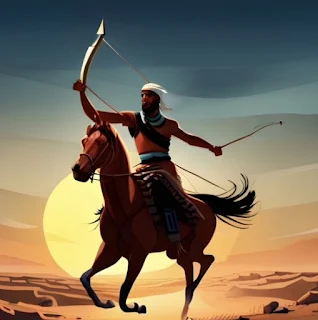Cosplay Nubian Armor Making Techniques
Nubian leather armor is a great choice for cosplay; it’s easy to work with and can create various African warrior styles from Nubia.
Directions on how to make cosplay Nubian leather armor are below.The ancient Nubians used various natural and metal materials to make armor. The most common type of Nubian armor was made from leather; also used were metal, a mixture of metal and leather and woven plant fibers.
The Nubian Empire reached its height during the 8th century BCE to the 4th century CE. This period is commonly referred to as the Napatan and Meroitic periods, which saw the Nubian kingdom of Kush become a major power in Africa, with its capital at Napata and later at Meroe.
Nubian Armor-Making Techniques to make for cosplay.
Armor played a pivotal role in Nubian warfare, enabling soldiers to safeguard themselves against adversary assaults and persevere on the battlefield.
The most common type of Nubian armor was made from leather. The leather was usually thick and reinforced with metal or bone plates to provide protection against arrows and other weapons. Leather armor could be fashioned into various styles, such as a breastplate, greaves, or bracers.
Nubian scale armor was made by attaching overlapping metal or animal horn scales to a leather or cloth backing. This type of armor was lightweight and flexible, providing protection while still allowing for ease of movement.
Mail armor, also known as chainmail, was made by linking small metal rings together to create a flexible mesh. This type of armor provided excellent protection against slashing and piercing weapons.
Nubian Lamellar armor was made by attaching small metal or leather plates to a backing material, such as leather or cloth. The plates were often overlapped to create a flexible armor that could be molded to the wearer's body.
Reed armor is a type of armor made from woven reeds or other plant fibers, which was used by various cultures throughout history including Nubians. Reed armor was lightweight and offered some protection against both cutting and piercing attacks, but was not as effective as metal armor.
Nubians developed their own styles of metal armor, including a distinctive type of helmet known as the Nubian cap. Nubian helmets were usually made from metal and often featured ornate designs, such as feathers, animal horns, or geometric patterns. Helmets were designed to protect the head and face from injury in battle.
Helmets were an important part of Nubian armor, designed to protect the head and face from injury in battle. The use of armor was a crucial element of Nubian warfare, allowing soldiers to protect themselves from enemy attacks and remain on the battlefield for longer periods of time.
How to make Nubian leather armor for cosplay.
Leather armor is a great choice for cosplay as it is relatively easy to work with and can create a variety of different looks depending on the style and color of leather used.
Making Nubian leather armor for cosplay materials and directions.
Materials Needed:
Leather (at least 4-5 oz thickness)
Scissors
Ruler
Pencil or pen
Hole punch
Leather lacing or cord
Leather dye (optional)
Leather sealer (optional)
Step 1: Design your armor
Using a reference image or your own design, sketch out the shape and size of the armor pieces you want to create on a piece of paper. Make sure to include all the necessary details and any markings or patterns that you want to add.
Step 2: Cut out the leather pieces
Using your paper template as a guide, trace the shape onto the leather using a pencil or pen. Then, use scissors to carefully cut out the pieces. For thicker pieces of leather, you may need to use a utility knife or rotary cutter.
Step 3: Create holes for lacing
Using a hole punch, create evenly spaced holes around the edges of each piece of leather where you will be lacing them together. Make sure the holes are big enough to fit your lacing or cord.
Step 4: Dye and seal (optional)
If you want to change the color of your leather, you can use leather dye to achieve the desired shade. Apply the dye according to the manufacturer's instructions and allow it to dry completely. Once dry, you can use a leather sealer to protect the color and finish.
Step 5: Lace the pieces together
Starting with the largest piece of armor, begin lacing the pieces together using your leather lacing or cord. Be sure to lace tightly and knot the ends securely. Repeat until all the pieces are attached and the armor fits properly.
Step 6: Add finishing touches
Depending on the design of your armor, you may want to add additional details such as studs, buckles, or other decorative elements. Use a hole punch or a needle and thread to attach these finishing touches.
With a little bit of patience and creativity, you can make your own leather armor for cosplay.
More about the Nubians conquered territories so you learn about the leather cosplay armor you are making.
The Nubian Empire reached its height during the 8th century BCE to the 4th century CE. This period is commonly referred to as the Napatan and Meroitic periods, which saw the Nubian kingdom of Kush become a major power in Africa, with its capital at Napata and later at Meroe.
During its height, the Nubian Empire, centered around the kingdom of Kush, conquered and ruled over various neighboring territories. These included parts of Egypt, which the Nubians conquered and ruled during the 8th century BCE as the Twenty-Fifth Dynasty.
The Nubians also conquered modern-day Sudan, Ethiopia, and Eritrea territories, including the Kingdom of Punt and the Kingdom of Aksum. Additionally, the Nubians established trade relationships with other neighboring regions, such as the Roman Empire and the Kingdom of Axum, and even sent a diplomatic mission to China during the 3rd century CE.
Throughout their history, the Nubians interacted with various neighboring cultures, including the ancient Egyptians, with whom they had both friendly and hostile relations. The Nubians were known for their skill in archery and were often employed as mercenaries by other powers in the region. They were also skilled in metalworking and produced high-quality iron weapons, armor and tools.













